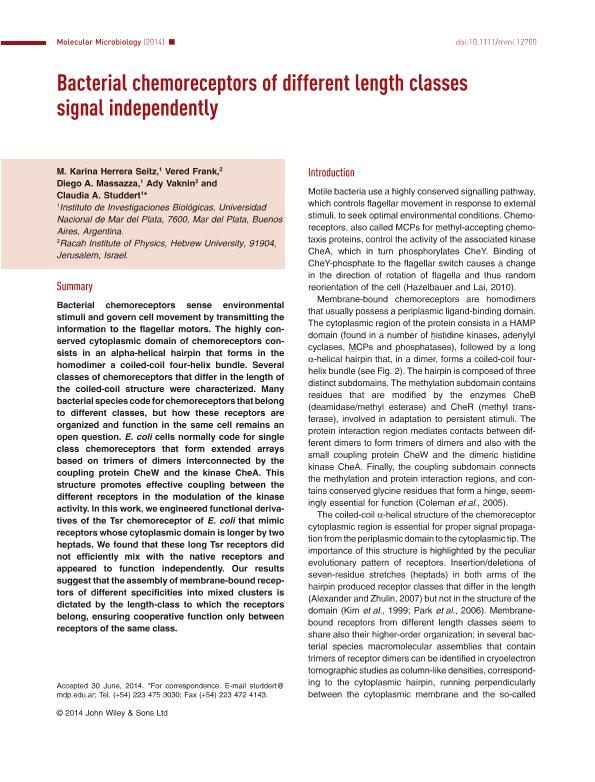Mostrar el registro sencillo del ítem
dc.contributor.author
Herrera Seitz, Karina

dc.contributor.author
Frank, Vered
dc.contributor.author
Massazza, Diego Ariel

dc.contributor.author
Vaknin, Ady
dc.contributor.author
Studdert, Claudia Alicia

dc.date.available
2017-02-16T13:58:22Z
dc.date.issued
2014-08
dc.identifier.citation
Herrera Seitz, Karina; Frank, Vered; Massazza, Diego Ariel; Vaknin, Ady; Studdert, Claudia Alicia; Bacterial chemoreceptors of different length classes signal independently; Wiley; Molecular Microbiology; 93; 4; 8-2014; 814-822
dc.identifier.issn
0950-382X
dc.identifier.uri
http://hdl.handle.net/11336/13068
dc.description.abstract
Bacterial chemoreceptors sense environmental stimuli and govern cell movement by transmitting the information to the flagellar motors. The highly conserved cytoplasmic domain of chemoreceptors consists in an alpha-helical hairpin that forms in the homodimer a coiled-coil four-helix bundle. Several classes of chemoreceptors that differ in the length of the coiled-coil structure were characterized. Many bacterial species code for chemoreceptors that belong to different classes, but how these receptors are organized and function in the same cell remains an open question. E. coli cells normally code for single class chemoreceptors that form extended arrays based on trimers of dimers interconnected by the coupling protein CheW and the kinase CheA. This structure promotes effective coupling between the different receptors in the modulation of the kinase activity. In this work, we engineered functional derivatives of the Tsr chemoreceptor of E. coli that mimic receptors whose cytoplasmic domain is longer by two heptads. We found that these long Tsr receptors did not efficiently mix with the native receptors and appeared to function independently. Our results suggest that the assembly of membrane-bound receptors of different specificities into mixed clusters is dictated by the length-class to which the receptors belong, ensuring cooperative function only between receptors of the same class.
dc.format
application/pdf
dc.language.iso
eng
dc.publisher
Wiley

dc.rights
info:eu-repo/semantics/openAccess
dc.rights.uri
https://creativecommons.org/licenses/by-nc-sa/2.5/ar/
dc.subject
Chemotaxis
dc.subject
Chemoreceptors
dc.subject.classification
Biología Celular, Microbiología

dc.subject.classification
Ciencias Biológicas

dc.subject.classification
CIENCIAS NATURALES Y EXACTAS

dc.title
Bacterial chemoreceptors of different length classes signal independently
dc.type
info:eu-repo/semantics/article
dc.type
info:ar-repo/semantics/artículo
dc.type
info:eu-repo/semantics/publishedVersion
dc.date.updated
2017-02-10T18:13:41Z
dc.identifier.eissn
1365-2958
dc.journal.volume
93
dc.journal.number
4
dc.journal.pagination
814-822
dc.journal.pais
Estados Unidos

dc.journal.ciudad
Hoboken
dc.description.fil
Fil: Herrera Seitz, Karina. Consejo Nacional de Investigaciones Científicas y Técnicas. Centro Científico Tecnológico Mar del Plata. Instituto de Investigaciones Biológicas; Argentina. Universidad Nacional de Mar del Plata; Argentina
dc.description.fil
Fil: Frank, Vered. The Hebrew University Of Jerusalem; Israel
dc.description.fil
Fil: Massazza, Diego Ariel. Consejo Nacional de Investigaciones Científicas y Técnicas. Centro Científico Tecnológico Mar del Plata. Instituto de Investigaciones Biológicas; Argentina. Universidad Nacional de Mar del Plata; Argentina
dc.description.fil
Fil: Vaknin, Ady. The Hebrew University Of Jerusalem; Israel
dc.description.fil
Fil: Studdert, Claudia Alicia. Consejo Nacional de Investigaciones Científicas y Técnicas. Centro Científico Tecnológico Mar del Plata. Instituto de Investigaciones Biológicas; Argentina. Universidad Nacional de Mar del Plata; Argentina
dc.journal.title
Molecular Microbiology

dc.relation.alternativeid
info:eu-repo/semantics/altIdentifier/url/http://onlinelibrary.wiley.com/doi/10.1111/mmi.12700/abstract
dc.relation.alternativeid
info:eu-repo/semantics/altIdentifier/doi/http://dx.doi.org/10.1111/mmi.12700
Archivos asociados
